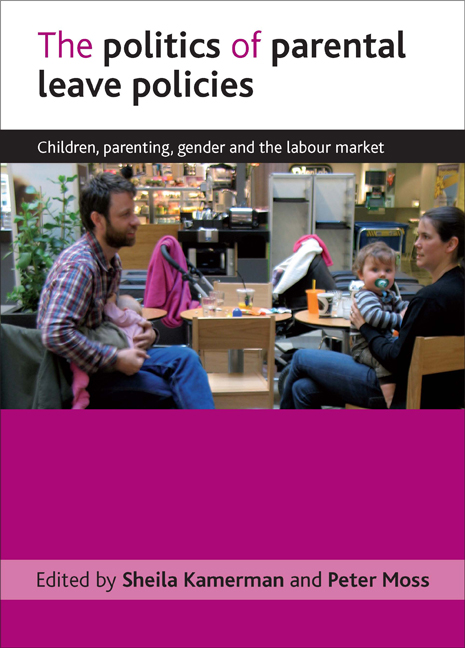Book contents
- Frontmatter
- Contents
- List of tables and figures
- Acknowledgements
- Notes on contributors
- one Introduction
- two Australia: the difficult birth of paid maternity leave
- three Canada and Québec: two policies, one country
- four Czech Republic: normative or choice-oriented system?
- five Estonia: halfway from the Soviet Union to the Nordic countries
- six Finland: negotiating tripartite compromises
- seven France: gender equality a pipe dream?
- eight Germany: taking a Nordic turn?
- nine Hungary and Slovenia: long leave or short?
- ten Iceland: from reluctance to fast-track engineering
- eleven The Netherlands: bridging labour and care
- twelve Norway: the making of the father’s quota
- thirteen Portugal and Spain: two pathways in Southern Europe
- fourteen Sweden: individualisation or free choice in parental leave?
- fifteen The European directive: making supra-national parental leave policy
- sixteen Conclusion
- Appendix
- Index
two - Australia: the difficult birth of paid maternity leave
Published online by Cambridge University Press: 05 July 2022
- Frontmatter
- Contents
- List of tables and figures
- Acknowledgements
- Notes on contributors
- one Introduction
- two Australia: the difficult birth of paid maternity leave
- three Canada and Québec: two policies, one country
- four Czech Republic: normative or choice-oriented system?
- five Estonia: halfway from the Soviet Union to the Nordic countries
- six Finland: negotiating tripartite compromises
- seven France: gender equality a pipe dream?
- eight Germany: taking a Nordic turn?
- nine Hungary and Slovenia: long leave or short?
- ten Iceland: from reluctance to fast-track engineering
- eleven The Netherlands: bridging labour and care
- twelve Norway: the making of the father’s quota
- thirteen Portugal and Spain: two pathways in Southern Europe
- fourteen Sweden: individualisation or free choice in parental leave?
- fifteen The European directive: making supra-national parental leave policy
- sixteen Conclusion
- Appendix
- Index
Summary
Maternity leave: none.
Paternity leave: none.
Parental leave: 52 weeks per family with no payment; the mother may start to use this leave up to 6 weeks before the birth and 6 weeks can only be taken by mothers.
Leave to care for sick children: 10 days per person per year at 100% of earnings + 2 days with no payment for each ‘permissible occasion’.
Other: none.
Australia is a federal state. It has a high level of part-time employment among women. Just over a third of mothers who worked in the 12 months prior to birth used some paid maternity leave and a quarter of fathers used some paid paternity leave; mothers are more likely than fathers to use unpaid leave. Overall, two thirds (68%) of mothers used some maternity or parental leave, but only 30% of fathers used any paternity or parental leave. These figures include non-statutory leave benefits.
Introduction
The absence of a national system of paid maternity or parental leave in Australia presents a puzzle: how is it that a country once regarded as a ‘social laboratory’ and renowned for its progressive social and industrial legislation (Roe, 1976; Castles, 1998) does not provide this basic entitlement for working parents? Even if a minimalist scheme of paid leave is introduced in the next year or two, as seems likely following the election of a Labor government, the lack of such leave to date requires explanation, especially since ‘work–life balance’ and ‘family policy’ have been prominent political issues for at least two decades (Pocock, 2003; Brennan, 2007). In seeking to explain this puzzle, one may locate Australian approaches to paid family leave (including maternity, paternity and parental leave) within the historical traditions of the welfare state in this country and the distinctive industrial relations regime that prevailed for much of the 20th century. These historical and institutional characteristics help to explain the absence of paid leave in this country, but they do not fully account for it. Both cultural values and party politics also matter a great deal.
The normative strength of the male breadwinner family has been critical in shaping Australian debates and policies on family support. Despite comparatively low levels of female labour force participation, Australian policy makers have eschewed ‘in-work’ benefits such as earned income tax credits.
- Type
- Chapter
- Information
- The Politics of Parental Leave PoliciesChildren, Parenting, Gender and the Labour Market, pp. 15 - 32Publisher: Bristol University PressPrint publication year: 2009
- 2
- Cited by



